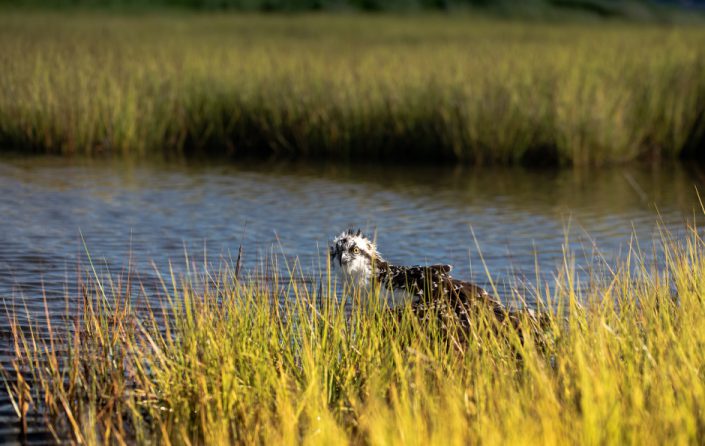Osprey 78/D: A Second Chance
“Chump” is rescued, rehabbed, and released
by Ben Wurst, Habitat Program Manager

On Sunday, July 30th I woke and checked my email early that morning. I had an urgent message from Deb Traster, who lives adjacent to the Long Beach Island Foundation of the Arts & Sciences (LBIF). She said that something was not right with one of the young ospreys that fledged from a nearby nesting platform where I banded three nestlings with red bands on July 5. One was on the ground and could not take off. Fearing the worst (entanglement), she checked it out and sought help. After getting in touch with me, I reached out to my buddy, Northside Jim to see if he could get there that morning.

Luckily, Jim could get there ASAP and rescued the bird with Deb’s help. Jim and I talked and we basically determined that the bird was malnourished. Since he was banded, we knew that Chump was the youngest of the brood (or the runt) and in times where food or prey is NOT plentiful, the youngest gets out competed for food. This is a trait that all ospreys (and some other birds) exhibit, called brood reduction. Since their eggs hatch in the order they are laid or asynchronously, and sometimes they can be a week apart in age, the stage is set for the oldest to survive in times when prey availability is diminished, i.e. “survival of the fittest” Luckily though, there was enough food for Chump to fledge, but not enough for him to thrive and find food on his own.

Giving Chump Another Chance (thanks to some great humans)!
No doubt Chump would have died if he wasn’t spotted down on the marsh. Adult ospreys do not feed young after they fall to the ground. With no food then the chance of surviving was grim. However, without any major injuries, we knew he was a great candidate for rehabilitation. With some food to fatten him up and some time in the flight cages, we knew he would be in great hands with Don Bonica, of Toms River Avian Care. Within three weeks I got the call that Chump was ready to be released. We decided to bring him back to LBIF, where he originated with the high hopes that maybe, just maybe the adults would welcome him back. That didn’t happen, but Chump did fly strong and high above the houses surrounding LBIF.

We are encouraged by the outpouring of support from the public for conserving ospreys and Project RedBand on Barnegat Bay.
- You can read the full story in this week’s edition of The SandPaper
- Learn more about Project RedBand
- Donate to support our Osprey Project!
Discover more from Conserve Wildlife Foundation of NJ
Subscribe to get the latest posts sent to your email.
Leave a Comment
Good job Deb, Jim, Don and of course, Ben. This should be a Disney movie.
It warms my heart, particularly in these harsh times where cruelty has become the norm, every time I read of human kindness to wild species. In each exchange, I sense ‘amends’, as are required in 12-step programs, for the harm we have done to nature all these centuries. Wishing this fine bird well, and thanking all its rescuers. Carolyn Foote Edelmann NJWILDBEAUTY nature blog…
Thank you for the wonderful story. I hope Chump makes it and have a nice long life. Perhaps he returns next year and someday raise his own babies.
Comments are closed.